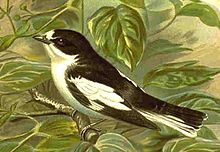Semicollared flycatcher
| Semicollared flycatcher | |
|---|---|
 | |
| Scientific classification | |
| Domain: | Eukaryota |
| Kingdom: | Animalia |
| Phylum: | Chordata |
| Class: | Aves |
| Order: | Passeriformes |
| Family: | Muscicapidae |
| Genus: | Ficedula |
| Species: | F. semitorquata |
| Binomial name | |
| Ficedula semitorquata (Homeyer, 1885) | |
The semicollared flycatcher (Ficedula semitorquata) is a small passerine bird in the Old World flycatcher family, one of the four species of Western Palearctic black-and-white flycatchers. It breeds in montane forests of the southeastern corner of Europe (Balkan Peninsula) to Northwest Iran. It is migratory, wintering in Central and Eastern Africa.[2] It is a rare vagrant in western Europe. Tracking studies using geolocators have revealed that weather conditions during spring migration can have a large impact on the timing of Semicollared flycatcher migration and survival of adult birds.[3]
This is a 12–13.5 cm long bird, intermediate in appearance between collared flycatcher and European pied flycatcher. It has often been classed as a subspecies of collared flycatcher.

The breeding male is mainly black above and white below, with a white half-collar, extending further back than in pied, large white wing patch, extensively white tail sides and a large white forehead patch. It has a pale grey rump. The bill is black and has the broad but pointed shape typical of aerial insectivores. It mainly takes insects in flight, rarely hunting caterpillars amongst the tree foliage like pied flycatcher.
Non-breeding male, females and juvenile semi-collared flycatchers have the black replaced by a pale brown, and may be very difficult to distinguish from other Ficedula flycatchers, particularly the collared flycatcher. A distinction is that semicollared may show a white second wing bar, but many individuals are not separable in the field.
Semicollared flycatchers are birds of belts of deciduous woodlands, especially oak and hornbeam, in mountainous areas. They build an open nest in a native tree-holes and old nests of woodpeckers, also the species can occupy nest-boxes.[4] The clutch size is 4-7 eggs. The song is again intermediate between collared and pied flycatchers, with slow strained whistles, but some rhythmic elements.

References
[edit]- ^ BirdLife International. (2018). "Ficedula semitorquata". IUCN Red List of Threatened Species. 2018: e.T22709319A131879858. doi:10.2305/IUCN.UK.2018-2.RLTS.T22709319A131879858.en. Retrieved 10 October 2021.
- ^ Briedis, M.; Träff, J.; Hahn, S.; Ilieva, M.; Král, M.; Peev, S.; Adamík, P. (2016). "Year-round spatiotemporal distribution of the enigmatic Semi-collared Flycatcher Ficedula semitorquata". Journal of Ornithology. 157 (3): 895–900. doi:10.1007/s10336-016-1334-6. S2CID 25641679.
- ^ Briedis, M.; Hahn, S.; Adamík, P. (2017). "Cold spell en route delays spring arrival and decreases apparent survival in a long-distance migratory songbird". BMC Ecology. 17 (11): 11. Bibcode:2017BMCE...17...11B. doi:10.1186/s12898-017-0121-4. PMC 5381016. PMID 28376915.
- ^ "Semi-collared Flycatcher in Armenia". In online publication "State of Breeding Birds of Armenia". TSE NGO, Armenian Bird Census Council. Retrieved on 1 Sep 2017. 2017. Archived from the original on October 12, 2017.


 French
French Deutsch
Deutsch